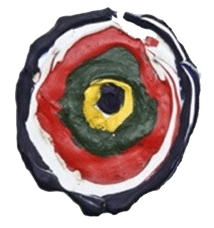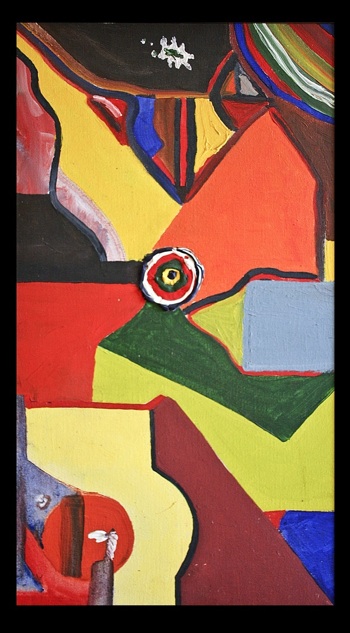Paschón
UPDATE: Since posting the original message, we have received a picture of the only known Paschón original. The authenticity has been verified by two individuals who attended the showing in Hawaii. We welcome your comments.
Comments - - - - - - - - - - - - - - - - - - - - - - - - - - - - - - - - - - - - - - - -
Al W. says:
What a privilege to finally see a Paschon masterpiece. As a somewhat
renowned art critic, I feel I have a flair for seeing a work of art
through the eyes of the artist. It appears that Paschon is looking
down on a one-eyed mother earth from above who seems to be staring
back at him as if to say…”don’t even think about coming down here
and messin’ with us”. Then the contrasting colors make the keyhole
at the bottom left just jump at you…it is obvious symbolism for the
entry point to mother earth. The jagged little white figure appears
to be a reflection of the aircraft Paschon is using to hover over
this location.
It is a glorious example of exquisite artistry and with this being
the only known original…is priceless.
Al W.
- - - - - - - - - - - - - - - - - - - - - - - - - - - - - - - - - - - - - - - - - - - - - - - - -
James J. says:
For years rumors have circulated on the underground art scene of
Paschón’s missing works. As both an art lover and critic, finally
seeing one of his masterpieces is inspiring. Many art critics
believe that the disappearance of this talented artist and his work
is a great loss to contemporary art.
As an ardent admirer of Paschόn, this has to be the piece entitled
“Turtle Eating Concrete.” Although I can relate to Al W’s critique,
I believe a much more appropriate interpretation of this work can be
broken down into three distinct areas: the eye, the fly, and the
candle.
The eye is gazing upward at the oddly shaped, white character near
the top of the work. This object represents a bug, so lifelike that
it appears to have flown into the canvas, that has just been eaten
by a bird that abuts the turtle’s head and is looking down from the
sky. The turtle would like to eat the bug as opposed to the concrete
block, representing the things in life we all want but cannot have,
often times from frustrations out of our control.
Turtles are reptiles that spend a significant amount of time in
water, represented by the blue area at the lower right. A breeze
from the water keeps the flying insect out of the reach of the
turtle. The bird is unaffected by the wind, even using its mystical
power to help capture the intruding prey. The flickering candle in
the lower left represents the wind’s direction.
A reflection of the candle can be seen in the sun-like object
behind. Paschón is saying that as the sun changes its position in
the sky, the wind’s direction will change and favor the turtle, much
like circumstances in our own lives change and help us attain the
treasures we seek, treasures being all things good, material and
ethereal.
Throughout this piece the contrasting color scheme and heavy use of
pastels suggest a glass half-full attitude on the part of the
artist. The use of stark divisions among colors is representative of
the tendency of opportunities to exude slowly in our lives, much
like a cool mountain spring, rather than rushing all at once.
It is a shame that we don’t have the artist to give us his
interpretation, but maybe that’s the way he planned it, to let each
of us make our own unique discernment of his genius and enjoy
forever this wonderful piece of modern art and brilliant display of
his mastery of color, form, and function. Paschón’s mysterious
disappearance is truly one of the great losses to art, society, and
culture.
James J.
- - - - - - - - - - -
- - - - - - - - - - - - - - - - - - - - - - - - - - - - - - - - - -
- - - -
Jewett' K. says:
I am pleased to able to finally see an oil painting created by
Paschon. Paschon’s painting at first glance shows a definite
influence by two movements in art history, Cubism and Impressionism.
In particular, I see the influences of Paul Cezanne, Henri Matisse,
and Pablo Picasso.
It is Paschon’s approach to space within the painting that resembles
the concepts of Picasso. There seems to be a sense of simultaneity
as if the artist is attempting to express the presence of the
objects within the space without confining the objects to a
two-dimensional point of view. Paschon seems to “envisage (the)
world in three dimensions but the surface of painting is
two-dimensional and (the) problem is as how to represent
three-dimensional sensations into two”. Instead, the artist allows
form to dictate a more accessible portrayal of the space, and notes
that “In Buddhist terminology the form is emptiness and the very
emptiness is form”. As a result, the lines of the piece create many
diagonals, angles and patterns in order to help us experience the
magic of the objects, no matter how ordinary, with a more open
special quality.
Like Matisse, the play between the shapes of the color fields and
line creates a visually harmonious composition. This harmony, paired
with the Picasso approach to space, allows for an almost ethereal
feeling to the piece. I feel that I know this is the artist’s goal
with this piece, as I feel that the painting is meant to be
“something vaster, deeper of human sensibilities, which goes beyond
the normal world of average reality.”
Thank you Paschon for allowing us to take a look at your fabulous
painting. You indeed invoke a great transcendence through your use
of color, line and special arrangement.

